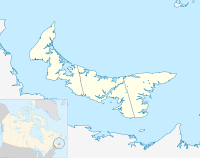North Cape is a cape at the northern-most extremity of Prince Edward Island, Canada.
It is the dividing point for delineating the western limits of the Northumberland Strait. An extensive reef made up of sedimentary rock extends into the Gulf of St. Lawrence from its low sandstone cliffs. The Canadian Coast Guard maintains a lighthouse as a navigational aid beacon.
The Meteorological Service of Canada has a remote weather station next to the lighthouse (ID - WNE).[1]
Wind farms
editNorth Cape Wind Farm is a small wind farm project built near Tignish, Prince Edward Island. Phase one was completed on November 16, 2001. With Phase two being completed in November of 2003 adding an additional 8 v-47 wind turbines. Each of which has the generating capacity of 660 kilowatts of electricity[1].The wind farm in North Cape now supplies 7.5% of Prince Edward Islands electricity.[2] The facility is owned and operated by the Prince Edward Island Energy Corporation, a Crown corporation that also owns and operates the Eastern Cape Wind Farm. The wind farm was constructed next to the existing Atlantic Wind Test Site at North Cape.[3] The federal government established a wind power test and research site at North Cape during the 1970s energy crisis on account of it being one of the most consistently windy locations in Canada. Since the 1990s a small commercial wind farm has been constructed adjacent to the test site.
The farm has sixteen Vestas V-47-660 wind turbines, and generates 10.5600 MW hours a year of electrical power.[4]
Capital to build the farm was raised through the purchase of PEI Energy Saving Bonds.[5]
The power is purchased by Maritime Electric Company Limited who then distributes it to customers.[6] The power is transmitted to their transmission station in Huntley PEI with a 69 kilovolt line which is twenty eight kilometres long. The lne was constructed under stage I.[7]
Wind Energy Institute of Canada
editThe Wind Energy Institute of Canada (WEICan) is a test site provided by the Federal Government of Canada along with the Provincial Government of Prince Edward Island for the development of small wind turbines. The site provides testing in a harsh environment, along with research and certification services for developers.[8]. WEICan opened in 1980, and was originally called the Atlantic Wind Test Site, which was a by-product of the 1970's energy crisis. It is now the country's official wind research and development facility [9]. The site provides a salt spray environment, along with extreme cold and high winds, which is ideal for the testing of small turbines designed for farms and isolated areas. Clients pay an hourly rate in order to cover the costs of running the institute. Whalepower blades first testing occurred at the site.
A $12 million grant was given to WEICan in order to construct a wind energy storage facility which is used to understand how much energy is lost when storing wind energy over different periods of time. The storage facility was completed in 2011 [10].
Hydrogen Village
editThe hydrogen village is Canada's first grid-independent sustainable energy system for northern and remote climates[11]. The site is still in the testing stages. Water molecules are split by the electricity produced by the wind turbines in order to create hydrogen and oxygen. The hydrogen molecules are stored on site in holding tanks. This system is designed for isolated climates. Hydrogen is produced when conditions are windy. When conditions are calm, the hydrogen, mixed with diesel, is used in generators in order to produce electricity[12].
Seaweed harvest
editDuring the summer, seaweed is harvested at the site. The seaweed is used in baking, fertilizer, and, until recently, as a stabilizer in commercial products.
Gallery
edit-
Windmills at North Cape
-
Wind turbines at North Cape
-
Harvesting Seaweed at North Cape
See also
editReferences
edit- ^ http://www.gov.pe.ca/energy/index.php3?number=60458&lang=E
- ^ http://www.gov.pe.ca/index.php3?number=news&lang=E&newsnumber=4992
- ^ http://www.gov.pe.ca/news/getrelease.php3?number=2352
- ^ http://www.canwea.ca/featuredWindFarm_e.php?farmId=44
- ^ http://www.gov.pe.ca/index.php3?number=news&lang=E&newsnumber=4992
- ^ http://www.gov.pe.ca/news/getrelease.php3?number=2352
- ^ http://www.gov.pe.ca/energy/index.php3?number=60458&lang=E
- ^ http://www.theglobeandmail.com/report-on-business/economy/growth/canadas-wind-innovation-put-to-the-test/article1391658/
- ^ http://www.gov.pe.ca/photos/original/wind_energy.pdf
- ^ http://www.theglobeandmail.com/report-on-business/economy/growth/canadas-wind-innovation-put-to-the-test/article1391658/
- ^ http://www.windh2.ca/
- ^ http://www.theglobeandmail.com/report-on-business/economy/growth/canadas-wind-innovation-put-to-the-test/article1391658/
External links
edit- http://www.tignish.com/northcape/
- Map of Canadian wind farms | http://www.canwea.ca/farms/wind-farms_e.php
Category:Prince County, Prince Edward Island Category:Headlands of Prince Edward Island Category:Wind farms in Prince Edward Island

